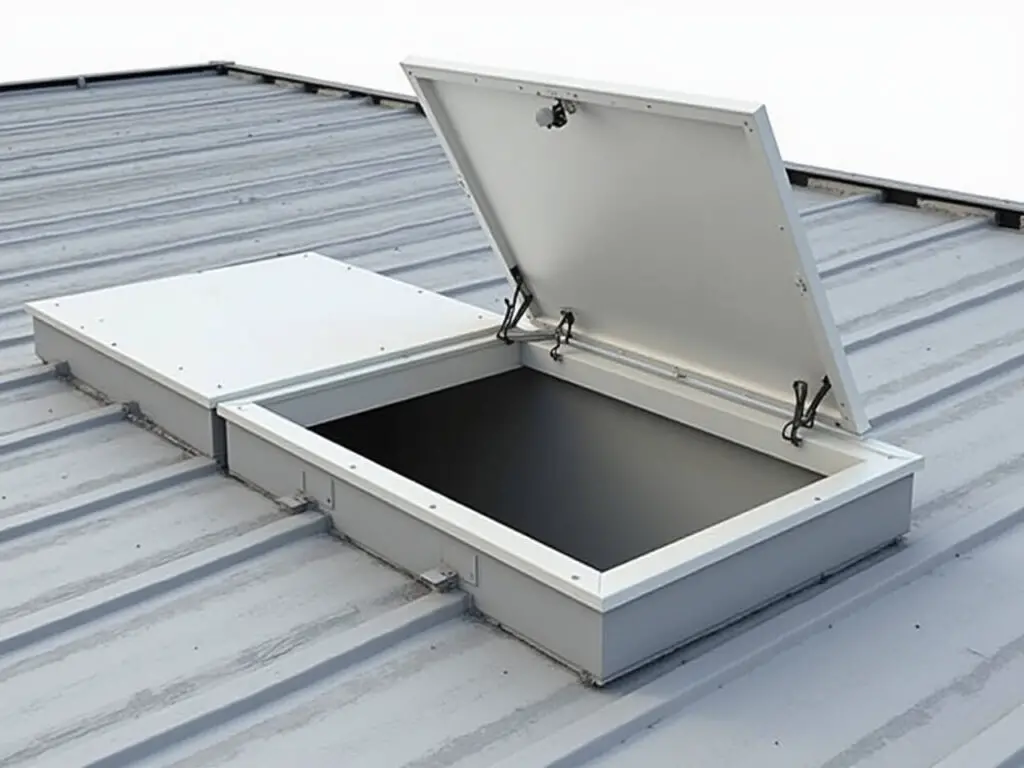Are you still using shaky ladders for roof and attic access? As general contractors and roofing experts, you know this is dangerous and inefficient. It risks worker safety and can cause potential project delays and higher costs.
Imagine transforming unsafe access points into safe pathways with a roof access hatch—an ideal solution for improved safety and easier access to residential, commercial, or industrial construction.
In this article, we’ll explore the drawbacks of traditional access methods, review various roof hatch options that follow industry standards, and provide expert tips for selection and installation. Get ready to enhance various spaces safely and efficiently!
The Roof Hatch Solution
Consider the roof access hatch to address traditional roof access challenges. This installation enhances safety and functionality for contractors and roofing specialists who manage building roofs and attics.
A roof access hatch is a secure entryway that allows safe passage between a property’s interior and the roof or attic. Unlike ladders, a well-installed roof hatch is a dependable part of any structure.
Types of Roof Hatches and Their Applications
When choosing roof access hatches, contractors and roofing specialists should understand the different types and their uses. Manual hatches are best when access isn’t as frequent, like during HVAC maintenance. Automatic hatches, which can be used with a button or remote, are better for larger homes that need regular access.
Fixed ladders offer a reliable way to reach the roof for maintenance and emergencies. For a more space-efficient choice, retractable stairs offer a foldable design that improves safety and accessibility.
It’s crucial to select the right materials for roof hatches. Aluminum is an excellent choice in humid places because it is lightweight and resists corrosion. Galvanized steel is great for fire resistance, while polycarbonate materials allow natural light in, brightening the area.
The opening mechanisms of roof hatches are also important. Excellent quality hinges and latches ensure they are weatherproof and secure, which makes the hatch more reliable.

Roof hatches serve many important purposes in homes and non-residential buildings. They allow easy access for HVAC maintenance, help install and keep solar panels, and aid in cleaning chimneys and vents. Additionally, these hatches can be effective escape routes during emergencies, making them a key feature in modern homes.
Long-Term Benefits for Homeowners and Professionals
Installing a roof access hatch during construction or renovation offers immediate benefits and long-term value for property owners and contractors.
- Enhanced Safety: Roof access hatches reduce ladder-related fall risks, improving worker safety and reducing insurance claims while providing property owners with convenient access for maintenance.
- Convenience and Efficiency: They simplify maintenance for rooftop systems like HVAC and solar panels, leading to quicker job completions and lower labor costs for homeowners.
- Increased Property Value: A roof access hatch can add value by enhancing attic utility and creating attractive rooftop spaces that appeal to potential buyers.
- Durability: Modern hatches are weatherproof and durable, preventing leaks and ensuring structural integrity. This results in fewer callbacks and peace of mind for property owners.
Mastering Codes, Standards, and Compliance
For general contractors and roofing specialists, installing a roof access hatch is essential for compliance with U.S. building codes and safety standards. Key points include:
- Building Code Compliance: Ensure hatches are sized and placed according to codes and do not obstruct fire exits.
- OSHA Safety Standards: To enhance safety, fixed access systems should be used over portable ladders, potentially including guardrails or fall arrest systems.
- Manufacturer Specifications: Follow installation guidelines to maintain functionality and warranties, as neglecting these can lead to safety hazards and costly repairs.
Choosing the Right Roof Hatch
Contractors and roofing experts must choose the right roof access hatch to ensure safety, efficiency, and client satisfaction. Ensure the hatch size accommodates your equipment and select a design that complements your building’s roof style.
Key Features to Consider
When choosing a hatch, focus on features that enhance function and safety. Measure the opening to fit your largest items. Select a material like lightweight aluminum for rust resistance or durable galvanized steel for fire resistance.
Look for high R-value insulation for energy savings and ensure the hatch meets fire rating standards. Consider the operation type—manual, automatic, or gas spring-assisted—and choose strong locking systems for security. Lastly, ensure the curb height prevents leaks.
Work With Trusted Suppliers
Collaborating with reputable manufacturers helps simplify the selection process. Choose from suppliers known for quality products and dedicated support to enhance safety and functionality.
Creating a Watertight and Secure Access Point
Proper installation of roof access hatches is vital for contractors and roofing specialists to ensure performance and prevent leaks. Here are essential guidelines for a secure and watertight hatch:
Structural Integration
For structural integration, aligning the rough opening with the hatch specifications is essential for creating a proper seal and keeping structural strength. Ensure the surrounding framing can support the weight of users and equipment.
Flashing and Waterproofing
Properly connecting the hatch curb and roofing system ensures the best performance and longevity of your flashing and waterproofing. Use high-quality underlayment and reliable flashing to channel water away and apply weather-resistant sealants at seams to prevent leaks.
Secure Fastening
Anchor the hatch, following the manufacturer’s instructions for a strong attachment. This will help prevent shifting and ensure safety over time.
Access Integration
To ensure safe access, install strong ladders or stairs next to the hatch and make sure they are anchored. This will offer an effortless way to enter and exit, improving safety.
Post-Installation Inspection
After installation, inspect it by checking the flashing and sealants for gaps. Test the hatch to ensure it opens and closes easily, then perform a water test around the area for leaks. This process ensures everything works properly and confirms that the job was done right.
Investing in Performance
Unsafe and inefficient access to roofs and attics complicates maintenance and poses safety risks. A roof access hatch is the perfect solution, enhancing safety and functionality.
For contractors and roofing specialists, recognizing the value of roof access hatches is essential. Installing them should be standard practice in modern construction. This smart investment improves job site safety and client satisfaction, contributing to safer and more efficient structures.
Prioritizing safe access will differentiate professionals and enhance their reputation for quality work.






